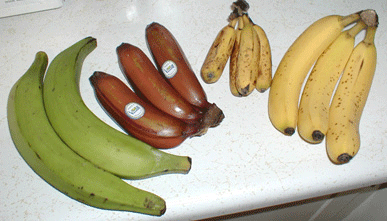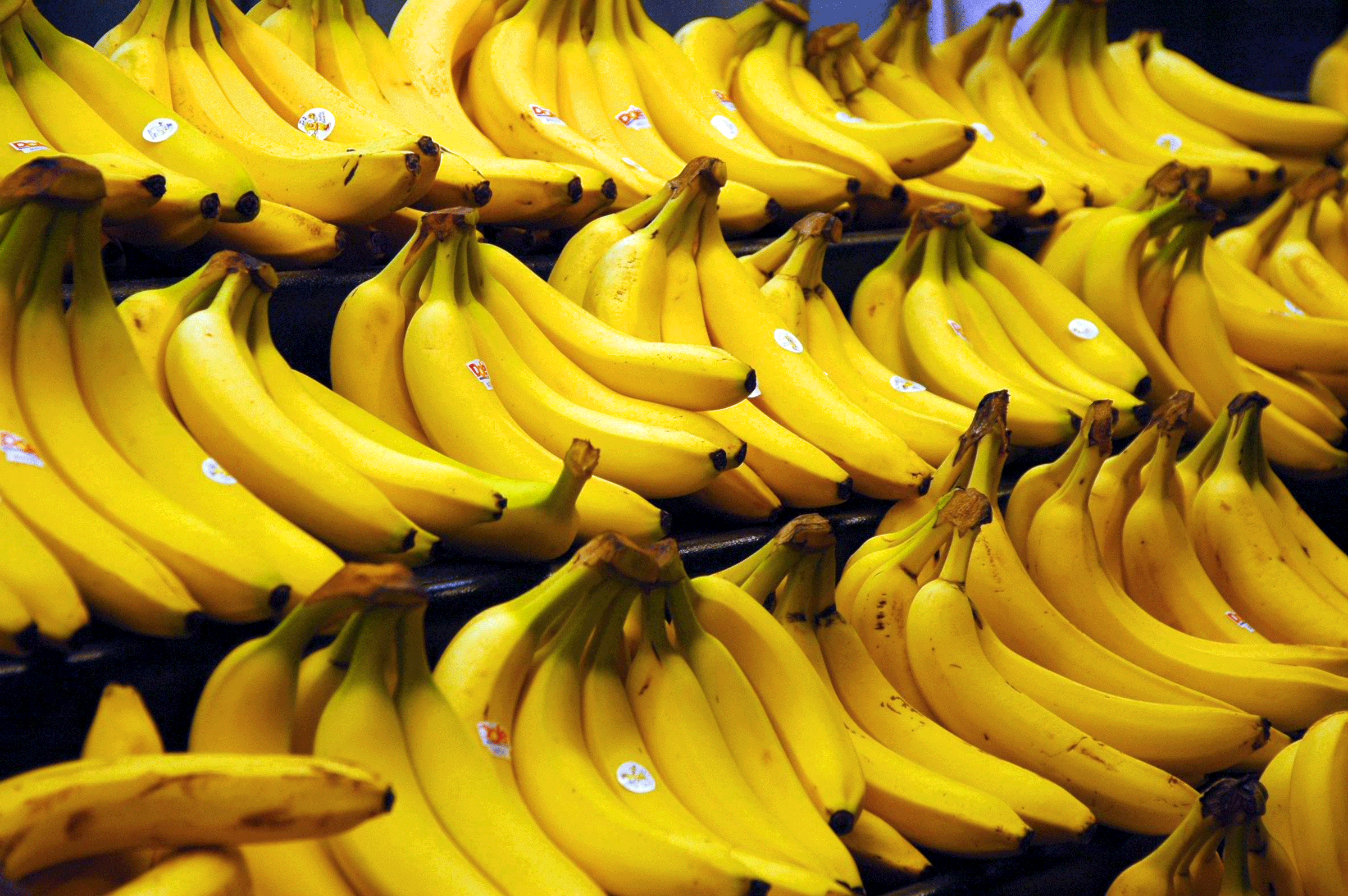Bananageddon
Air Date: Week of April 18, 2014

North American and European Consumers may have to adapt to a new banana if the Tropical Race 4 Panama Disease reaches Latin America. (Wikipedia Commons)
Update-The deadly fungus Tropical Race 4 Panama Disease that destroys bananas broke out in Asia, but over time has spread to the Middle East and Africa. University of Florida plant pathologist Randy Ploetz tells host Steve Curwood that scientists are now concerned that the disease could also make its way to Latin America.
Transcript
CURWOOD: It's Living on Earth, I'm Steve Curwood. Well, some pessimists have dubbed the potential cataclysm for the luscious yellow fruit "Bananageddon" - so to check on its status a decade on -- we turn back to Randy Ploetz who was featured in that 2004 story. Randy is a plant pathologist at the University of Florida. Welcome back to Living on Earth.
PLOETZ: Thank you.
CURWOOD: Professor Ploetz, did Bananageddon happen? Has the Tropical Race Four Panama disease made it out of Asia and into Latin America?
PLOETZ: In Latin America we don’t know yet. It certainly has made it to the Middle East. There are at least two locations in the Middle East, Jordan and Oman, also in Mozambique recently there was an export plantation of Cavendish there established by some Norwegian investors, but we don’t know whether it’s made its way into Latin America yet. Time will tell. But the way this thing has moved from Southeast Asia to the Middle East and Africa recently has us believing that it is possible, that it can make that next continental jump and can go from those areas to the Americas.
CURWOOD: Jordan, Mozambique...these aren’t exactly next door...how does a disease get there?
PLOETZ: Yeah, that’s one thing we’re concerned about. We’ve always known how this thing moves, and it’s traditionally in banana seed pieces is the easiest way for this thing to move great distances. We know from past work on this with Race One in the Americas a long time ago that movement in soil and on farm equipment in water - once this pathogen gets into a drainage basin and that water from a river or lake is used to irrigate the banana it’s a very effective way then to re-inoculate that crop every time you irrigate the crop. So that’s well understood. In this situation, from what we know, it’s possible that the pathogen has moved on workers’ clothing or shoes or by some other means to those areas, and if it’s that’s easy to move this thing great distances, it’s then possible to move it from Africa and the Middle East to the Americas. So that’s our big concern.
CURWOOD: How containable is this disease if it were to show up?
PLOETZ: It’s very difficult. Very, very difficult. There are no examples of anyone, knowing how bad this disease is, identifying an initial outbreak and being able to restrict that outbreak to a given area. It’s a really insidious kind of a cryptic hidden type of pathogen that really doesn’t rear its ugly head until it’s widespread and causing a lot of damage, so it’s very difficult to manage. And there are no fungicides that will manage it, there is no cultural practice that is known that can manage it, we’re kind of stuck between a rock and a hard place on that one.
CURWOOD: Back when Bob McCarty did this story for us in 2004, scientists were working on developing a genetically-engineered Cavendish banana that would resist this disease. So far, how much luck have they had?
PLOETZ: [LAUGHS] Not much. This is a really difficult disease to come to grips with. The banana is a very very difficult crop to improve, and unfortunately there aren’t a lot of scientists that are working on bananas. I mean, it’s very different than maize or soybeans or wheat where there are lots of scientists who are concerned about it. Banana, a very important crop, but very few scientists who are doing work to improve it.

(Wikipedia Commons)
CURWOOD: What about introducing new species of bananas to market. You know those purple bananas or the little finger-sized ones we sometimes see in markets here? How might they do if the Cavendish needs to be replaced?
PLOETZ: Yeah, there are a lot of different types of bananas out there. Cavendish is just one of many different types that are available. The problem is the Cavendish is so so productive and consumers in the US and Europe expect Cavendish bananas. Between you and me, I mean, there are other better tasting bananas out there than Cavendish. The problem with those other bananas is to consumers like myself and others, they might taste better - the Cavendish consumer often doesn’t like those other tastes. And the problem with those other ones as well in addition to the non-Cavendish type taste, is that they don’t produce as well. So if you did plug those into a Cavendish-type production system, you just wouldn’t get the yields, and you’d have to charge quite a bit more to be able to sell those bananas to a consumer like you or myself in the developed world. If you go into Whole Foods and you look at Apple bananas for instance in the supermarket, they’re a dollar a pound, they’re a lot more expensive than Cavendish.
CURWOOD: Hmmm. Randy Ploetz is a plant pathologist at the University of Florida. Thanks so much for taking this time.
PLOETZ: It's my pleasure.
Links
Living on Earth wants to hear from you!
Living on Earth
62 Calef Highway, Suite 212
Lee, NH 03861
Telephone: 617-287-4121
E-mail: comments@loe.org
Newsletter [Click here]
Donate to Living on Earth!
Living on Earth is an independent media program and relies entirely on contributions from listeners and institutions supporting public service. Please donate now to preserve an independent environmental voice.
NewsletterLiving on Earth offers a weekly delivery of the show's rundown to your mailbox. Sign up for our newsletter today!
 Sailors For The Sea: Be the change you want to sea.
Sailors For The Sea: Be the change you want to sea.
 The Grantham Foundation for the Protection of the Environment: Committed to protecting and improving the health of the global environment.
The Grantham Foundation for the Protection of the Environment: Committed to protecting and improving the health of the global environment.
 Contribute to Living on Earth and receive, as our gift to you, an archival print of one of Mark Seth Lender's extraordinary wildlife photographs. Follow the link to see Mark's current collection of photographs.
Contribute to Living on Earth and receive, as our gift to you, an archival print of one of Mark Seth Lender's extraordinary wildlife photographs. Follow the link to see Mark's current collection of photographs.
 Buy a signed copy of Mark Seth Lender's book Smeagull the Seagull & support Living on Earth
Buy a signed copy of Mark Seth Lender's book Smeagull the Seagull & support Living on Earth

